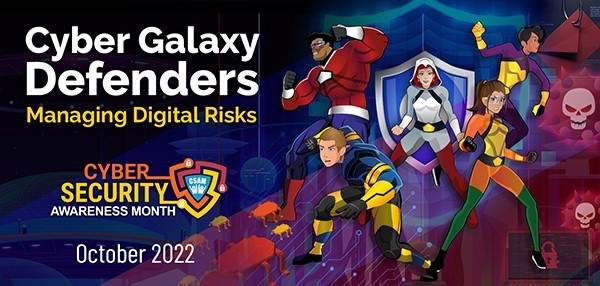Doctor’s Orders: Keeping Healthy from Malware and Ransomware
Cyber Security Awareness Month

Welcome to the final week of Cyber Security Awareness Month (CSAM)! This week, we will be covering malware and ransomware. No one likes to be infected, including your devices. It is important to know how to prevent malware and ransomware attacks to keep yourself and your organization cyber safe!
CSAM Cyber Check-Up
Infection: Malware - Malicious software, better known as malware, is software or code that is deployed on a device with the intention of compromising your data or system’s confidentiality, integrity, or availability. Malware can include viruses, worms, and trojan software. You can be infected by accidentally downloading malware while trying to download what you think is legitimate software or documents.
Prevention:
- Be aware and alert when downloading software or documents.
- Always check the web address (URL) is accurate by checking for spelling errors and misrepresented logos before clicking.
- Avoid phishing attacks. Clicking on a link, opening attachments or downloading a file from a malicious email is one of the most prevalent delivery methods cyber criminals use to deploy malware or ransomware on their victims.
Infection: Ransomware
Ransomware is a type of malware that makes data inaccessible by locking your device or encrypting your files. It can spread from your device and infect the rest of your organization’s data. Threat actors will often request money in return for regaining access to your files or threaten to leak private information if they do not receive payment.
Prevention:
- Stay up to date on trends in ransomware attacks. For the latest tips and advice on dealing with ransomware, check out this resource on Cyber Attacks.
- Backup your data regularly so you can recover data compromised with a ransomware attack.
Remedy: Malware and Ransomware
- Report the attack to your organization and law enforcement to prevent further attacks or a malware infection spread.
- Change all passwords to your online accounts. For more tips, check out this article on Passwords.
A 2021 survey conducted by CyberEdge found that 61.2% of Canadian respondents dealt with ransomware in 2021. It is important to take preventative action, but it is also important to think about WHEN you will be attacked and not IF you will be attacked. Make sure you stay up to date on cyber security awareness training so that you are prepared to protect yourself and your organization from malware or ransomware attacks!
For more information, head over to the Knowledge Library on the Cyber Security Ontario Learning Portal.


